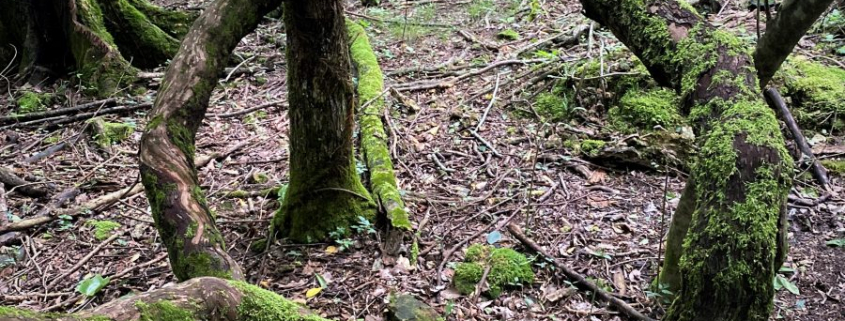Blue Trail Loop at Joe Wheeler State Park
July 7, 2020 I hiked Joe Wheeler State Park’s Blue Trail with State Parks Naturalist Emeritus Mike Ezell. Together we explored at a leisurely pace, not willing to race through the forest at the price of missing any of Nature’s magic.
The Parks do a good job with signage at Joe Wheeler. I hope that the interpretive signage at least slows a few people, encouraging them to learn as much as they can about the wildness through which they trek. Mike and I likely were among the few hikers who paid any attention to the tree upon which this trail sign is posted. Both of us know and appreciate the distinctive blocky bark and dark complexion of persimmon (Diospyros virginiana). Wikipedia offers some useful insight: The persimmon is the edible fruit of a number of species of trees in the genus Diospyros. The most widely cultivated of these is the Asian or Japanese persimmon, Diospyros kaki. Diospyros is in the family Ebenaceae, and a number of non-persimmon species of the genus are grown for ebony timber. Below right Mike is holding an early season drop, fruit aborted by the tree for some reason, perhaps a bumper crop (too many fruit to support through the summer) or insect damage. Persimmons turn a bright orange when ripe, and generally are too bitter to eat and enjoy until after the first frost. Many people wonder how we naturalists can be so adept at identifying tree species by bark alone. Mike and I have decades of practice, which lifts recognition to a level of second nature. Persimmon is simply an easy species. No other tree in our forest can be confused with persimmon.
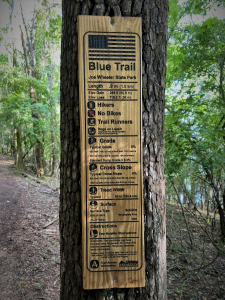
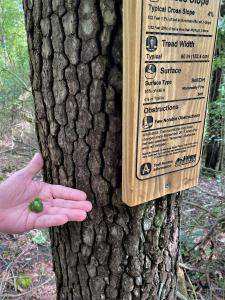
Some Delightful Discoveries
I’ve mentioned before that I am aching to know more about our north Alabama fungi, a life-kingdom unto itself. I am further stimulated by colleagues these past couple of years introducing me to our native edible mushrooms. I limit my actual harvesting and consumption to only those species that do not have similar local species that might make me ill… or worse. I ask that you read my comments without rushing into the woods to collect and prepare your own repast unless you first conduct considerable research. In other words, don’t risk your health and life using me as your only guide. I refuse to be responsible for what you place in your skillet and on your plate! These dandies below are summer oyster mushrooms (Pleurotus pulmonarius). They fry up nicely with butter, olive oil, and a few spices — delectable! We found these growing on a deceased hackberry or sugarberry (genus Celtis); we are both fuzzy about distinguishing these two common species.
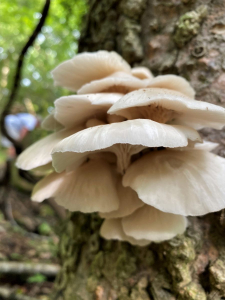
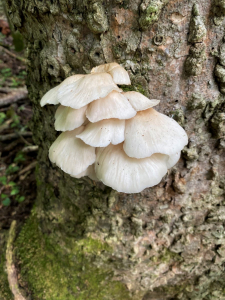
Also on a dead Celtis, we found these now-desiccating jelly ear mushrooms (genus Auricularia). The forest along the Blue Trail proved to be rich with mushrooms for several reasons. The forest is 80-90 years old, reaching a stage in development when many main canopy individuals are dying, leaving considerable dead or down woody debris standing or fallen to the forest floor. Keep in mind that stasis does not exist in living systems; life and death are in continuing balance. More than average rainfall had fallen month after month for the preceding one-half year, sustaining an environment perfect for decay and mushroom development. And a third reason we found so many fungal fruiting bodies is that we were consciously searching for them. As I’ve said often in these Posts, so much in Nature lies hidden in plain sight. So true is my statement: When we know where to look and how to see, we often find what we seek!
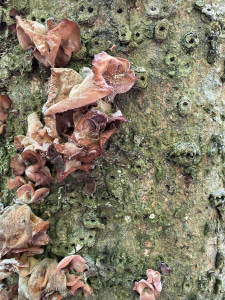
Ebony spleenwort (Asplenium platyneuron), from Wikipedia, is a fern native to North America east of the Rocky Mountains. It takes its common name from its dark, reddish-brown, glossy stipe and rachis, which support a once-divided, pinnate leaf. Our north Alabama forests are rich with fungi and other nonflowering plants. I enjoy immensely having the leisure to stroll through the woods with eyes tuned to the life and variety at my feet. Imagine what I would miss if I were intent simply on passing through the forest to reach some destination, blind to what lies underfoot.
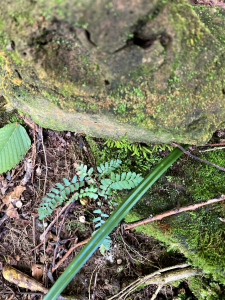
I don’t recall previously seeing these small columnar mushrooms (below left). Because that photo does not do justice to the peculiar nature of Xylaria, I borrowed the closer image (below right) from MushroomExpert.com. Detail from the same website: The genus Xylaria consists of funky, club-like decomposers of wood or plant debris that become black and hard by maturity, reminiscent of carbon or charcoal. The mushrooms are “Pyrenomycetes,” which means they produce spores in asci that are embedded in tiny pockets called “perithecia”; the asci take turns growing into the narrow opening of the pocket so that they can shoot spores away from the fungus and into the air currents. I found comfort on the web site, which emphasized that differentiation among species is almost impossible without a powerful microscope at hand, and the knowledge to see and discriminate. I will leave such detailed identification to the experts. My simple hope is that I can remember the genus Xylaria!
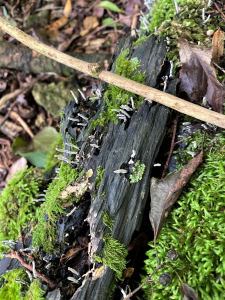
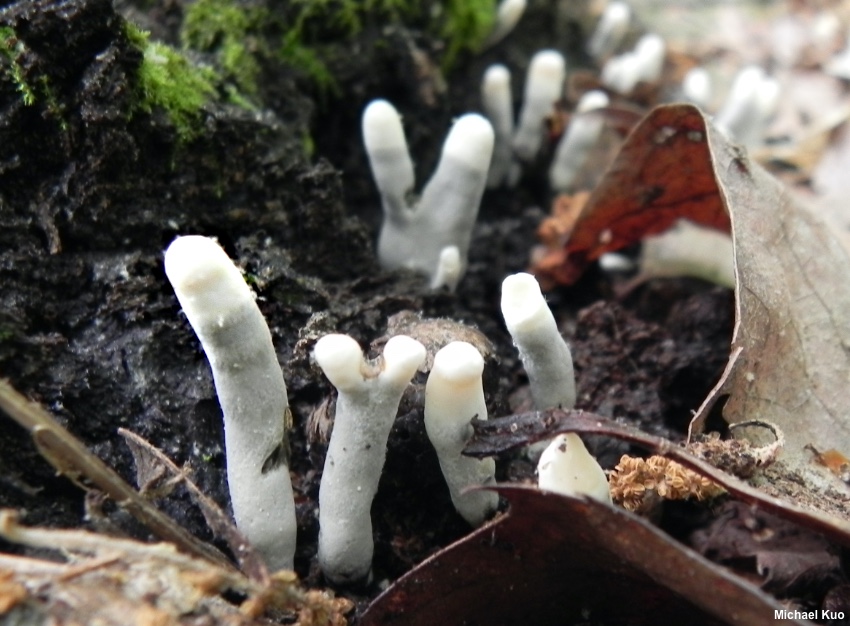
Nonflowering plants, in this case mosses, colonize every surface in some of our damp, well-watered shady groves. The leprechauns surely decorated this sylvan setting — every elevated surface of wood, whether dead, down, or standing, supports a moss-mat. I expected to see a crew of woodland nymphs (of legend and folklore) tending the moss garden! Perhaps we should have returned at dusk when the evening gloaming blessed and encouraged such non-human affairs.
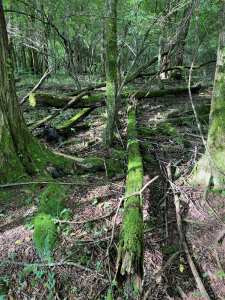
An Alaska Mid-Summer Interlude!
As with everything in Nature, where we are defines relative values for scale, beauty, productivity, and other comparisons. The so-termed mossy glen along the Blue Trail at Wheeler pales to insignificance to the lower-slope rain forest on the Mount Verstovia Trail rising above Sitka, Alaska (below). Sitka averages 120 inches of rain annually, well over twice our north Alabama average. Add in Sitka’s lower temperatures, frequent cloudy days, and seasonally nearly constant fog… the result is WET! The mid-June day I snapped these photos in 2012 as I ascended the trail, I reluctantly turned back when I encountered a coarse residual snowpack more than three feet deep. Conditions are relative. What would be considered extreme in one location is the norm elsewhere. Because I have made 13 interstate moves as an adult, I have learned to appreciate Nature’s beauty, magic, wonder, and awe wherever I am. I refuse to allow, for example, my memories of southeast Alaska wanderings to diminish my appreciation for a mossy glade at Joe Wheeler State Park.
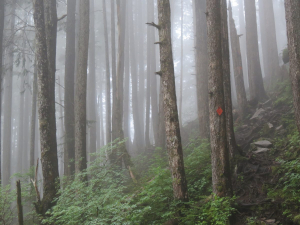
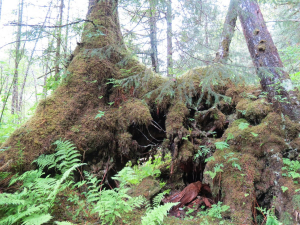
I will never tire of seeing the marvel of a mature beech’s bark wearing a full-color palette of moss and lichen… the beech extending its roots from a buttressed base, holding tight to Mather Earth, exploiting moisture and nutrients from soil with reach. Again, below right, southeast Alaska’s rainforest likewise offers tree-form inspiration of a different sort. I can admire and embrace both without one diminishing the other. Yes, I would like to spend a future week exploring the Sitka forests once more… with my retirement-honed eye for Nature (quite matured over the intervening eight years) and with the camera I now carry. However, Sitka requires at least three commercial flights, months of planning, and considerable expense. In contrast, I can drive the 47 miles to Joe Wheeled in under an hour without pre-planning. I have long ago resolved to seek satisfaction, enjoyment, fulfillment, and inspiration from Nature within reach of where I am.
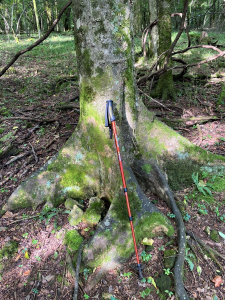
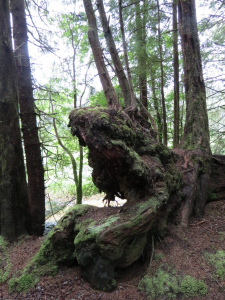
Back to Joe Wheeler State Park
Our ubiquitous grape vines scribe a special signature of form and artistry to our local forest images. Perhaps one day I will sit leaning against a nearby oak tree for hours to admire this particular vine… attempting to recreate the 80-90-years of growth, form, and stresses that forced…or permitted…its looping architecture.
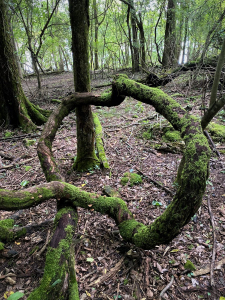
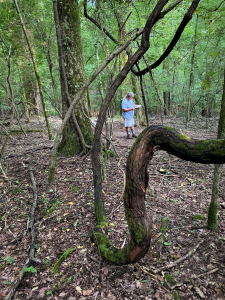
Or maybe I could just assume Mike’s version of Rodin’s The Thinker pose to ponder the life of a grape vine!
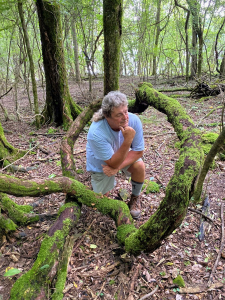
No thinking required to interpret the scene below. Some force of Nature (wind, lightning, ice?) split and brought a pole-size tree to the ground, split-side up. Decay and falling leaf and tree-litter detritus has created a fertile and welcoming seed bed for loblolly seed to germinate creating conditions for a potential nurse log. However, I remind myself that ample rains had fallen regularly to-date through this initial growing season for these first-year seedlings. Abundant rains have now yielded to our normal summer season of hit and miss showers. Here at my residence I have measured just a tenth of an inch over the past 12 days. If a similar drying period has affected the Blue Trail, these tender seedlings will desiccate and die, putting an end to their brief flourish on what seemed a perfect garden spot. I draw an important lesson for life and living — things aren’t always what they seem. A perfect germination bed becomes inhospitable over the normal flow of the seasons.
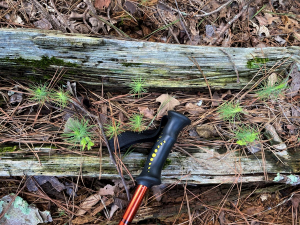
The Blue Trail offers an enjoyable hike through maturing second-growth forest, rich with stories of succession, death and dying, life-richness, and renewal. You need not worry about ascending mid-summer into snowpack too-deep to navigate. We discovered so much by paying focused attention, looking closely, and finding delight well within reach.
Alabama State Parks Foundation
I’ll remind you that I serve on the Alabama State Parks Foundation Board, in part because of my love of Nature and in recognition for my writing many prior Posts about visiting and experiencing the Parks. I urge you to take a look at the Foundation website and consider ways you might help steward these magical places: https://asparksfoundation.org/ Perhaps you might think about supporting the Parks System education and interpretation imperative: https://asparksfoundation.org/give-today#a444d6c6-371b-47a2-97da-dd15a5b9da76
The Foundation exists for the sole purpose of providing incremental operating and capital support for enhancing our State parks.
Thoughts and Reflections
Here are some simple truths affirmed by our couple-hours stroll:
I have long ago resolved to seek satisfaction, enjoyment, fulfillment, and inspiration from Nature within reach of wherever I am.
When we know where to look and how to see, we often find what we seek!
Inhale and absorb Nature’s elixir. May Nature Inspire, Inform, and Reward you!
Note: All blog post images created & photographed by Stephen B. Jones unless otherwise noted. Please circulate images with photo credit: “©2020 Steve Jones, Great Blue Heron LLC. All Rights Reserved.”
Another Note: If you came to this post via a Facebook posting or by an another route, please sign up now (no cost… no obligation) to receive my Blog Post email alerts: http://eepurl.com/cKLJdL
And a Third: I am available for Nature-Inspired Speaking, Writing, and Consulting — contact me at steve.jones.0524@gmail.com
Reminder of my Personal and Professional Purpose, Passion, and Cause
If only more of us viewed our precious environment through the filters I employ. If only my mission and vision could be multiplied untold orders of magnitude:
Mission: Employ writing and speaking to educate, inspire, and enable readers and listeners to understand, appreciate, and enjoy Nature… and accept and practice Earth Stewardship.
Vision:
- People of all ages will pay greater attention to and engage more regularly with Nature… and will accept and practice informed and responsible Earth Stewardship.
- They will see their relationship to our natural world with new eyes… and will understand more clearly their Earth home.
Tagline/Motto: Steve (Great Blue Heron) encourages and seeks a better tomorrow through Nature-Inspired Living!
Steve’s Three Books
I wrote my books Nature Based Leadership (2016), Nature-Inspired Learning and Leading (2017), and Weaned Seals and Snowy Summits: Stories of Passion for Place and Everyday Nature (2019; co-authored with Dr. Jennifer Wilhoit) to encourage all citizens to recognize and appreciate that every lesson for living, learning, serving, and leading is either written indelibly in or is powerfully inspired by Nature.
I began writing books and Posts for several reasons:
- I love hiking and exploring in Nature
- I see images I want to (and do) capture with my trusty iPhone camera
- I enjoy explaining those images — an educator at heart
- I don’t play golf!
- I actually do love writing — it’s the hobby I never needed when my career consumed me
- Judy suggested my writing is in large measure my legacy to our two kids, our five grand kids, and all the unborn generations beyond
- And finally, perhaps my books and Blogs could reach beyond family and touch a few other lives… sow some seeds for the future

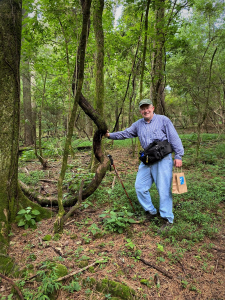
All three of my books (Nature Based Leadership; Nature-Inspired Learning and Leading; Weaned Seals and Snowy Summits) present compilations of personal experiences expressing my (and co-author Dr. Wilhoit for Weaned Seals and Snowy Summits) deep passion for Nature. All three books offer observations and reflections on my relationship to the natural world… and the broader implications for society. Order any and all from your local indie bookstore, or find them on IndieBound or other online sources such as Amazon and LifeRich.

